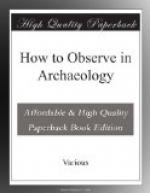All fragments showing a rim or spout, handles or part of a base, should be preserved until they can be compared with a more perfect specimen.
The following fabrics, however, are widely distributed, and usually seem to have flourished in the order in which they are here described:
A. Hand-made wares, rough within, but smooth or burnished surface, self-coloured (drab or brown), or intentionally coloured black (by charred matter in the clay, or by a smoky fire), or red (by a clear fire, sometimes aided by a wash or ‘slip’ of more ferruginous clay). Sometimes a black ware is ‘overfired’ to an ashy grey.
In such wares ornament is rare, and consists mainly of (a) incised dots, dashes, or lines, in simple rectilinear patterns (chevrons, zigzags, lozenges), often enhanced by a white chalky filling (V, Figs 5- 8); (b) ridges or bosses modelled in the clay surface, or adhering to it. The forms are plump and globular, often round-bottomed or standing on short feet. Rims are absent or ill-developed; necks actually prolonged into trough-spouts or long beaks; handles are very simple and short. Vases are sometimes modelled like animals, or have human faces or breasts (V, Figs. 1-4).
These wares begin in the Stone Age, and seem to predominate in the early and middle Bronze Age. Locally they may have lasted even later, but the use of the potter’s wheel spread rapidly in the early Bronze Age.
B. Hand-made wares of light-coloured clay, with painted decoration, usually in black or reddish-brown. The paint is generally without glaze, but sometimes is decayed and easily washes off.
The forms and ornaments resemble those of class A, but are less rude and more varied. Distinct rims and standing-bases appear, and spouts give place to a pinched lip.
C. Hand-made wares of black or other dark clay, with painted decoration in white or ochre. These fabrics are rather rare, and the paint is easily washed off. The forms follow those of class B.
Classes B and C seem to begin early in the Bronze Age, and are gradually replaced by the corresponding wheel-made fabrics of class D.
D. Wheel-made pottery begins in the Bronze Age, and is distinguished by its symmetrical forms, and by the texture of the inner surface, especially about the rim and base, where the potter’s fingers have grazed the whirling clay. Self-coloured wares still occur, and are sometimes elegant (’bucchero’ ware); but the improved furnaces now permit general use of light-coloured clays, suited to painted decoration. Glazed paint is still rare, and may be taken as probable token of date not earlier than the end of the Bronze Age. The glaze-painted wares of the Greek island-world occasionally wandered to the mainland a little earlier than this, but not far from the coast. On wheel-made pottery the ornament is either (a) applied while the pot is on the wheel, and consequently limited to lines and bands following the plane of rotation, or (b) added afterwards, free-hand, usually between such bands, and especially on the neck and shoulder.




